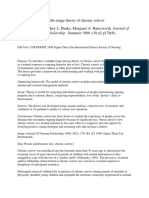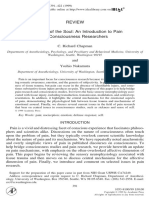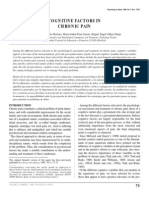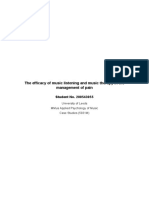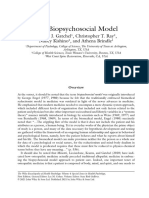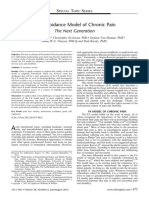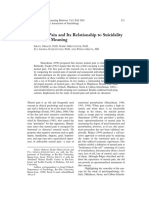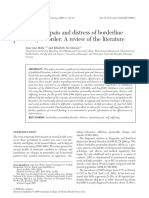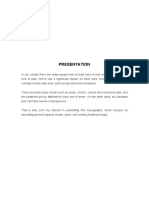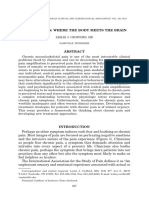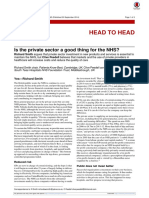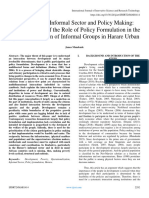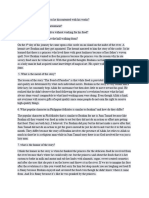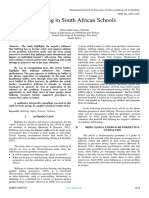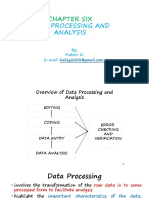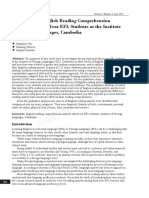British Journal of Pain 2015 Osborn 65 83
British Journal of Pain 2015 Osborn 65 83
Uploaded by
MarinaPapaCopyright:
Available Formats
British Journal of Pain 2015 Osborn 65 83
British Journal of Pain 2015 Osborn 65 83
Uploaded by
MarinaPapaOriginal Description:
Copyright
Available Formats
Share this document
Did you find this document useful?
Is this content inappropriate?
Copyright:
Available Formats
British Journal of Pain 2015 Osborn 65 83
British Journal of Pain 2015 Osborn 65 83
Uploaded by
MarinaPapaCopyright:
Available Formats
British Journal of Health Pryrhofogy (I998), 3.
65-83 Printed in Gtwt Britain 65
0 1998 The British Psychological Society
The personal experience of chronic benign lower
back pain: An interpretative phenomenological
analysis
Mike Osborn’
Pain Clinic, Friend’ Outpatients, Royal United Hospital, Combe Park, Bath BAI 3NG, UK
Jonathan A. Smith
Lkpartment of Pfycbofogy, Uniwfity of Sbeffifd, W u t m Bank, Sbefifd SIO 2Te UK
Objectives. Chronic low back pain is a major health problem and one where pain,
physical impairment and biological pathology are only very loosely correlated). It is
considered that the experience of pain, its distress and disability is mediated by its
meaning to the sufferer. The intention of this study was to explore the sufferers’personal
experience of their pain.
Design. Qualitative research is often recommended to complement the quantitative
work on chronic pain that has been published to date. Interpretative phenomenological
analysis was employed in an in-depth study of a small sample of chronic pain
patients.
Method. Semi-structured interviews were carried out with nine women pain patients.
The verbatim transcripts of those interviews served as the data for an interpretative
phenomenological analysis.
Results. Four themes emerged which are described under the broad headings:
searching for an explanation; comparing this self with other selves; not being believed;
and withdrawing from others.
Conclusions. The participants shared an inability to explain the persistent presence
of their pain or to reconstruct any contemporary self-regard. While they used social
comparisons to try and help them make sense of their situation, these comparisons
proved equivocal in their outcome. Participants were unable to establish the legitimacy
of the chronic nature of their pain and in certain situations felt obliged to appear ill to
conform to the expectations of others. By default, participants treated their own pain as
a stigma and tended to withdraw from social contact. They felt confused, afraid for their
future and vulnerable to shame.
Chronic lower back pain is a major health problem and produces a demand on the medical
health services which cannot be satisfied as 85 per cent of cases are not amenable to a
diagnosis requiring the attention of a medical consultant (Clabber Moffat, Richardson,
*Requests for reprints.
Downloaded from bjp.sagepub.com by guest on July 10, 2016
66 Mike O s b m andJonathan Smith
Sheldon & Maynard, 1995). Rather, in chronic lower back pain, psychological factors are
of prime importance in the determination of a patient’s disability (Waddell, 1987).
Bonica (1974) described chronic pain as exclusively ‘malefic’, as he felt it was
powerfully destructive of the physical and psychological well-being of individual,
family and associates and had no redeeming features. However, there is a considerable
variability in the individual response to chronic pain according to its context and
meaning to the sufferer (Hanson & Gerber, 1990; Holzman & Turk, 1986; Turk & Flor,
1984). The challenge is to understand the relationship between pain, distress and
disability, which is neither linear nor causal, but dynamic and multidimensional
(Waddell, 1987).
Behavioural approaches view chronic pain in two ways. Firstly, it is suggested that it
can arise as the result of secondary muscular hypertension induced by a fear of pain,
causing muscle spasm, ischaemia and exaggerated pain perception (Flor, Turk &
Birbaumer, 1985). Secondly, it is seen as a behaviour maintained by secondary gain,
where external reinforcement contingencies prompt the development and maintenance of
a chronic problem (Fordyce, 1976).
According to cognitive theorists, distorted evaluations of the sensation of pain are
considered to lead to feelings of hopelessness, low self-efficacy, and a lack of control and
turn an acute problem into a chronic one (Harkapiiii, Jiirvikoski & Vakkari, 1996;
Holtman & Turk, 1986; Keefe, Dunsmore & Burnett, 1992; Turk & Flor, 1984; Turk &
Rudy, 1992). Lefebvre (1981) found that the cognitive distortions of chronic low back
pain patients were similar to those of clinically depressed patients. Catastrophization,
frustration, pessimism, self-criticism and pain preoccupation have each been associated
with distress in the sufferer.
Pain-specific beliefs are also important. The fear-avoidance of pain (Slade, Troup,
Lethem & Bentley, 1983) is rooted in the incorrect assumption that the sensation of
chronic pain signals the presence of an ongoing disease process and damage (Riley, Ahern
& Follick, 1988) and dictates the need to rest. Rest is contraindicted in chronic pain and
fear-avoidance has been shown to be predictive of the development of a chronic pain
career (Waddell, Newton, Henderson, Somerville & Main, 1993).
Studies directed explicitly at exploring the personal meaning of chronic pain are rare in
the psychology literature, although such an approach is consistent with the social
cognition paradigm in clinical health psychology (Skevington, 1995; Taylor, 1983).
Hubner (1984), in his clinical observations, placed pain at the heart of the individual’s
experience of their lives:
Pain had posed the ultimate question of meaning; that is, dominated by pain, and distracted by
nothing, what did these patients live for? What gave their lives meaning? (p. 446).
Hubner considered that pain challenged the sufferers’ meanings about their life and in so
doing isolated them from those around them. To be in pain, involved ‘being separated,
being alone. At no time are we more alone than when we are in the grip of pain’ (p. 447).
LeShan (1964) worked with patients in severe pain of long duration and he described
the relationship between chronic pain and meaning as problematic. He felt their chronic
pain was typified by ‘utter senselessness’and ‘meaningless’. The attempt to gain control
and understanding of what is senseless prompted LeShan to compare chronic pain with a
nightmare, its only adequate expression-a scream.
Downloaded from bjp.sagepub.com by guest on July 10, 2016
Chronic benign lower back pain 67
The impact of a chronic disabling condition such as pain on the individual, is described
by Bury (1982)as a ‘biographical disruption’. Here, the chronic illness calls into question
both the sufferer’s past and future, and requires him or her to rethink each one. Williams
(1 984) also argued along similar lines that chronic illness could prompt a ‘narrative
reconstruction’. In the absence of other facts, this draws on the individual’s lay beliefs to
account for the onset of their illness but again demands that they reconfigure their
biography, past and present. More recent studies emphasize the impact of chronic illness
on the sufferer’s self-concept and the contrast within that between private sense of self and
public social identity (e.g. Kelly, 1992;Yoshida, 1993).
Empirical research to date has clarified and classified the chronic pain phenomenon
(Turk & Flor, 1984;Jamison, Rudy, Penzien & Mosley, 1994;Jensen, Turner, Romano &
Lawler, 1994).However, although in each case the researchers have identified important
constructs and patient profiles that are characteristic of chronic pain, they have been
unable to address how or why such behaviours and beliefs are formed or maintained.
Further research is often recommended in order to gain a greater awareness of the personal
meaning of pain to the sufferer (Craig, 1984;Holzman & Turk, 1986).Leventhal(1993)
considered the need for meaning to be given a central focus in the study of pain because:
It has long been clear that the meaning given a somatic (pain) experience will play a crucial role in the
activation of the emotional-motivational component of the pain system (p. 142).
Pain is now both defined and recognized as a subjective experience and this has had
important implications in its study enabling a greater focus to be directed towards
phenomenological and contextual influences (Anand & Craig, 1996;Encandela, 1993).
Despite such recommendations, the number of published empirical studies on the
personal meaning of pain is limited, and research is most often to be found within the
medical sociology literature (e.g. Baszanger, 1992;Bendelow & Williams, 1995;Bury,
1988). This study is concerned with and aims to explore explicitly the psychological
processes which determine and maintain the dynamic relationship between the partici-
pants’ chronic pain, distress and disability. It therefore adopts a phenomenological,
‘insider’s perspective’ (Conrad, 1987).At the same time the paper is neither a first-hand
personal account nor a second-hand clinical case report. The specific methodological
approach adopted is interpretative phenomenological analysis (IPA) (Smith, 1996a).IPA
is committed to understanding and foregrounding the patient’s perspective but recog-
nizes that this is only possible through the interpretative analytic work of the
investigator. The published report can therefore be considered as a co-construction
between participant and analyst in that it emerges from the analyst’s engagement with
the data in the form of the participant’s account. IPA is an idiographic qualitative methodology
which involves the analysis of verbatim transcript derived from indepth semi-structured
interviews with participants (Smith, 1995). If the meaning of pain to the patient is to be fully
explored then we would argue such an intensive qualitative approach is required.
Method
The data set for this study consists of transcribed semi-structured interviews with nine women who attend a
hospital out-patient back pain clinic.
Each participant attended the clinic following a referral from her general practitioner and was considered
on assessment to have chronic back pain with no treatable organic pathology but with excessive distress and
Downloaded from bjp.sagepub.com by guest on July 10, 2016
68 Mike O s b m and Jonathan Smith
disability. Their pain behaviours and symptoms and signs were ‘inappropriate’ according to the criteria
described by Waddell & Main (1984) and were recognized to be an index of their distress (Waddell, 1987).
They are part of a particular group of chronic pain patients who report high scores of distress and disability
with little peripheral organic pathology.
The participants’ names along with other identifying information have been changed to preserve their
anonymity and guarantee confidentiality. Their ages ranged between 25 and 5 5 years and in each case they
had endured their pain for at least five years.
The semi-structured interview procedure followed that described by Smith (1995). It involved the
construction of an interview schedule-outlining the areas of interest to be discussed during the interview.
However the schedule is not intended to be prescriptive-it acts as a guide for the interview but does not
dictate its exact course. During the interview, questions are adapted to the specific context and interesting
issues which arise are probed. The aim is to facilitate the participant telling her own pain story, not to check
the investigator’s preconceptions of pain. The verbatim transcripts of the interviews served as the raw data to
be analysed using an interpretative phenomenological method described below (Smith, 1995). Participants
were not regarded as exemplars of the ‘chronic pain patient’ or expected to speak explicitly for their peers but
rather to provide specific instantiations of the psychological experience of chronic pain.
The analytic process proceeded as follows:
1 . Interview transcripts were read, and reread a number of times, to ensure a general sense was obtained of
the whole nature of the participant’s accounts. During this stage notes were made of potential themes and
the process was informed by the researcher’s experience of the interview itself.
2. Returning to the beginning, the text was reread and any emergent themes identified and organized
tentatively.
3. Attention was then focused on the themes themselves to define them in more detail and establish their
interrelationships. The focus was on the psychological content of the phenomenon under study and the
data were now being condensed.
4. The shared themes were organized to make consistent and meaningful statements which contributed to an
account of the meaning and essence of the participants’ experience grounded in their own words.
Thus the analysis which follows is organized around themes which emerged from the transcripts, rather than
constructs predicted in advance. Consonant with the phenomenological approach these themes are then
considered in relation to the extant literature in the Discussion section.
Validity
Validity, and the exercise of sufficient rigour to establish the credibility of qualitative study is considered to
be no less essential than in any other form of research but it is important that the criteria by which it is
judged are appropriate as qualitative inquiry has different epistemological roots to quantitative methodology
(Smith, H a d & Van Langenhore, 1995a, b). A number of authors have attempted to explicate alternative
ways in which the validity of qualitative research can be assessed (Conrad, 1990; Lincoln & Guba, 1985;
Smith, 19966; Stiles, 1993). Conrad (1990) makes a distinction between the assumptions of qualitative and
quantitative research in regard to generalizability suggesting that when considering a qualitative study,
rather than looking at sample size, statistical power or participant selection the work should be measured by
the applicability of the concepts. For example, how would the concept of ‘uncertainty’, which is referred to in
this study help articulate aspects of the chronic pain experience in other situations.
Smith (1996b) suggested several criteria to assess the internal validity and reliability of qualitative
research. Two important ones are: internal coherence and the presentation of evidence. Internal coherence
refers to the need to concentrate on whether the argument presented in the study is internally consistent and
justified by the data. In addition Smith proposes that suf6cient verbatim evidence from the participants
should be presented in the paper to allow the reader to interrogate the interpretation.
As a check on the analysis, the first three transcripts were looked at independently by the second author.
After this the two authors discussed their readings of these interviews and came to an agreement on the theme
categories before analysis proceeded onto the subsequent transcripts. At every stage of the project the second
author acted as a check on the emergent analytic account.
It is important to note that these procedures-both on the part of the analysts and of the paper’s readers-
are not intended to produce a single definitive reading: e.g. the two investigators were not aiming to produce
Downloaded from bjp.sagepub.com by guest on July 10, 2016
Chronic benign lower back pain 69
a satisfactory inter-rater reliability score but rather to veri$ that the particular analysis presented has been
systematically achieved and is supported by the data. Thus the aim of validity checks on qualitative work is to
ensure that the particular account presented is a sound one warrantable from the data, not to prescribe the
singular true account of the material.
Analysis
This section presents the four superordinate themes that emerged from the analysis,
which were: searching for an explanation, comparing this self with other selves, not being
believed and withdrawing from others.
The first theme, ‘searching for an explanation’, sets the scene for those which follow as
it articulates the participants’ attempts to understand what is happening to them and is
a prerequisite for the subsequent self-reflection. Because such questioning recurs
throughout the analysis, it is only presented briefly at the outset.
Searcbing fw an explanation
Participants were not asked specific, closed questions but simply to describe their pain
and the various ways it had affected them. They showed a strong motivation to
understand and explain their situation, to know ‘why?’:
I just keep asking myself why the pain is there and I haven’t got an answer. I don’t know how I should
feel really it’s just that I don’t think it should be there why should I have it? I would have thought that
after all this time it should have eased up and gone away but it hasn’t (Linda).
Participants regularly stated they simply could not ‘believe’that nothing more could
be done to relieve their pain. There was a marked contrast between their preoccupation
with their pain and their inability to account for its chronic presence. Despite their long
history of pain and extensive contact with the health service they neither felt informed
about their condition, nor able to influence it. Their pain was often felt to act of its own
volition. ‘It just comes and goes when it wants really (Alice) ’.
Linda’s account of her situation suggested that despite wanting to understand why she
had chronic pain, she could not; to her it was ‘unbelievable really’. This was not a simple
account of ignorance but a profound state of bewilderment as she failed consistently
to understand why she should be suffering. As the best efforts of others had failed, she felt
she could only blame herself:
I’m sort of mad at myself I start banging things and getting so aerated with myself that it’s there and I
can’t get it to go away.
Becky also had no answer as to why her pain remained, except to imagine the presence of
physical damage or deterioration:
Well I always thought you had pain to tell you when there was something wrong.
Participants could not explain the persistence of their pain in any manner which was
meaningful to them beyond the notion that ‘there was something wrong’, something
biomedical which demanded attention. Their disbelief and bewilderment prompted
frustration, anger and, in Becky’s case, despair:
But I don’t know why you have to keep suffering it and suffering it and suffering it for ever and ever.
Downloaded from bjp.sagepub.com by guest on July 10, 2016
70 Mike O s b m and Jonathan Smith
Each participant rejected the judgment that the pain was ‘unreal’but could not explain
its reality in a manner that was meaningful to her. Their accounts revealed their attempts
to cope with their pain despite a profound lack of either understanding or information.
This uncertainty and ambiguity pervades their experience and will continue to appear as
an important factor in each of the following three sections.
Comparing this self with other selves
As participants described their pain, they compared themselves with other people
and with themselves both in the past and projected into the future. This creative
process of comparison captured the pernicious impact of their pain. One participant,
Linda, appeared to reach out to what she saw and, by comparing her present
situation with selected events she had witnessed, used those comparisons as
benchmarks:
I’m only 50 and I should be doing this that and the other cos they say life begins at 40 but I can’t and I
s’pose it does bother me, it’s frustrating that people of my own age are you can see them flying their
kite and you feel as if you can’t.
Linda could not do the things she felt she ‘should’ be able to do like other women of her
age who were active and enjoying life. Her comparison was not just of reduced mobility
but of the denial of pleasure in activity. Others her age could enjoy their life and celebrate
it free from pain, ‘you can see them flying their kite’, and this emphasized her feelings of
loss. In one passage, Linda recalls a description of her pain-free self, set amidst her
immediate family:
I just think I’m the fittest because there are 3 girls and I’m the middle one and I thought well I’m rhe
fittest and I used to work like a horse and I thought I was the strongest and then all of a sudden it’s just
been cut down and I can’t do half of what I used to do.
Linda’s description of her loss was exacerbated by the recall of an idealized past where
she was not only fit, but the ‘fittest’, and worked not just hard, but ‘like a horse’. As she
anticipated the future, Linda was afraid that she could only worsen progressively. She
could not predict her future and emphasized her pessimism by her comparisons with two
people, her mother and a school friend, who both died in distressing circumstances. She
admitted that neither of them had chronic pain but could not guarantee that she would
not share their fate:
She was a school mate and she was 15 month older than me and it was last year she started, I don’t
know what she died of she was getting these aches and pains I just don’t want it to be any worse as I
don’t want to be pushed round in a wheel chair.
The same uncertainty described earlier is what leads Linda to have such a gloomy
perception of a possible future. Gail also described her situation as one where continual
pain had eroded her mobility but responded differently to the comparisons she made with
others:
When I see all of my friends, I saw one running for the bus the other day I thought Oh my God it’s
ages since I had a good run or a good walk, you know. So for about 5 minutes I felt sorry for myself,
and then I saw somebody else in a wheelchair so you know, I’m not quite as bad as that.
Downloaded from bjp.sagepub.com by guest on July 10, 2016
Chronic benign lower back pain 71
Through comparison, participants often ranked themselves against others and this
served to highlight their loss or disability. Linda felt demoted within her family whilst,
for Gail, although she felt better off than someone in a wheelchair she became
embarrassed when considered alongside her 81-year-old mother-in-law:
You think oh well can I make it over there or shall I say no we’ll leave it for another day. I feel so stupid
especially when my mother-in-law is 81 and she’s trotting about and I am hobbling.
Other participants related similar comparisons. Their social order had been disturbed
and in attempting to re-establish their personal status, participants, like Gail, often took
refuge in thinking of those in a worse situation than themselves:
I try to tell myself I’m luckier than a lot of people, you know I haven’t got cancer (Ruth).
However, the use of others as an aid to resisting the sense of decline and loss that
pain provided was equivocal and in some cases detrimental, serving only to exacerbate
and define their distress. Participants’ uncertainty in their prognosis handicapped
any compensation that a ‘worse world’ offered. When Linda witnessed those
more disabled than her she felt she may be looking at herself in the future. ‘I just don’t
want it to be any worse as I don’t want to be pushed round in a wheel chair’. Dottie also
admitted that, although she looked at others in a worse position it could not compensate for
her own sense of deterioration and only increased her fear for the future:
I’ve done heaps more things than other people have done so I think well, I would, you always think
well there’s loads of people far worse off than you you know so you try to think of other people who are
permanently in wheelchairs, and it’s supposed to make you feel better which in a way it does but
basically its frightening.
This comparison with others who were more unfortunate was intended or considered as
a strategy for enhancing self-esteem but often turned into a reinforcer of despair. Chronic
pain promoted distress in each participant when they recalled how they were before it
began and a sense of grief pervaded their accounts. Although a few took pride in their
ability to cope, they often defined themselves as bereaved.
Nelly believed she had lost everything, her comparisons were global and catastrophic,
whilst Mary-Ann was more operational and explicit about the change she had experienced
and revealed how her pain frustrated her personally:
It’s stopped everything, it’s stopped my life completely (Nelly).
I can’t do what I used to do I’m not one for staying in house if I can get away with it I go out I don’t
like stopping in house (Mary-Ann).
As we have already seen with Linda, when participants reflected on their situation they
often recalled a better time, a nostalgic time associated with a better sense of self.
Memories were recalled to help maintain some morale in the present:
When you don’t feel you have a future, you live in the past. (Rachael).
Participants often referred to a past where they were as they had always wished to be,
fit, active, able to stay slim, interesting, and sociable. Alice grieved for her personality;
she wanted to be the ‘old Alice’, the Alice who could exercise regularly to keep her weight
Downloaded from bjp.sagepub.com by guest on July 10, 2016
72 Mike Osborn and Jonatban Smith
down, do and eat what she liked, and feel confident and happy:
Well my personality’s gone, I used to be right bubbly and lively and you know, but it’s, that’s gone,
and even my mum says that I’ve changed, she never really says in what way, she says I’ve got more
snappy and more nasty. You want the old Alice back but you can’t.
The nostalgic recall of the past provided some comfort but was again a comparison that
proved to be equivocal. The idealized accounts of the past served as a painful index of
what had been lost, and what now had to be endured on a daily basis, rather than as a
haven of reassurance and source of self-regard. The strength of their loss was accentuated
by the fact that the past-self was often considered to represent the real self, replaced
irrevocably by a new false persona:
You feel like just not particularly giving up but you don’t fef thrpcrson that you ure [author’s emphasis]
that you’re capable of feeling or capable of doing basically. It makes you feel a bit down and a bit
miserable (Dottie).
‘The person that you are’ is the person Dottie was in the past, the person without pain.
Through their selective use of social and personal comparison participants highlighted
the impact of their pain on their self-regard and the equivocal nature of their attempts to
cope with its imposition. Pain denied them the chance to be who they once were and
preferred still to be. Their contemporary self-regard contrasted with a nostalgic recall of
their past and those around them, and their comparisons served almost inevitably as an
index of their sense of threat and loss. Attempts to buttress self-esteem by comparison
with those more unfortunate often proved counterproductive and served only to remind
participants of their own gloomy prognosis.
Not being believed
Apart from their behaviour, the participants’ condition revealed no visible signs that
would give credence to any of their claims to suffering or disability. The participants,
who themselves endured a profound sense of uncertainty regarding the aetiology or
legitimacy of their pain, felt vulnerable to the judgments of those around them:
It’s like anger building up in you. It’s like if you’re talking to people you’re forever, its as though
you’ve got to try and convince them that there’s something wrong with you, that get’s you down
(Alice).
The participants felt a continual need to justify their pain as ‘real’,that is not in any way
psychogenic which was synonymous with ‘mad or bad’:
It’s quite embarrassing because its nor something that you can see and I do feel guilty, I know that my
back really does hurt and I’m not making it up and I feel sort of angry that I can’t do it and I think well
I wish I could just prove to them that my back really is bad and that I really must not do it, because if I
do I put myself back weeks (Dottie).
In the absence of any recognition that their pain could persist, participants were by
default required to be defensive about their condition, but were unable to make use of any
credible explanatory story and as a consequence were often frustrated:
You feel as though no-one believes you, unless people who have got bad backs, it’s only them who’d
believe you (Alice).
Downloaded from bjp.sagepub.com by guest on July 10, 2016
Chronic benign lwer back pain 73
Pain had caused a shift in the participants’ social roles and relationships and denied
them the opportunity to be the kind of daughter, grandmother, or lover that they, or
others, might wish them to be. Ruth and Gail were well aware of the potential problems
of being misunderstood by their lovers and parents:
I mean you don’t look ill, you’re not flat on your back, so you know, is it an excuse, oh I’ve got a
headache, do you know what I mean [not to have sex with her husband] (Ruth).’
She (mother-in-law] wanted her house decorating the other week. I said I can’t even do my own and I
feel guilty that she’s going to have to pay somebody to do it (Gail).
Each participant’s account exposed her awareness of the threat of rejection, not just
because she was a burden and unproductive but because she might be disbelieved. In
Gail’s case, the lack of credible evidence prompted a feeling of guilt that others suffered
too.
Mary-Ann was concerned with being judged as ‘useless’ because she could not look
after her family. This was a judgment she endorsed herself as, in common with Nelly and
other participants, she felt uncomfortable at being the recipient of care, unable to
reciprocate:
I know I am ill, but I think well why should I have to put that on to somebody else’s shoulders I don’t
want people to look after me and I know they love me but I don’t want it. It’s degrading (Nelly).
The difficulties of feeling believed had a paradoxical effect on the behaviour of
participants as a healthy appearance was considered by those around them to be
incompatible with any claims of chronic pain, suffering or disability:
If I went round with no make-up and bags hanging down my face or something and just look really
badly they’d probably think well yes, but you can’t see pain so they don’t know do they so they
automatically assume that there’s nowt wrong with you (Alice).
Appearing healthy or mobile whilst remaining in pain was problematic and participants
felt obliged to appear ill and disabled to satisfy the requirements of others. Unfortunately,
appearing ill left them feeling equally as prey to the consequences of pity and condemna-
tion. Pity to Nelly was a stigma. It degraded her, challenged her place in her social world
and was incompatible with how she wanted to view herself, or be seen by others:
I just want to say ‘hello’, you know, ‘how are you’ and I go ‘alright thanks’. Not look at me as though
I’m a cripple. I’m not a cripple.
The ambiguity of pain behaviour and the lack of understanding in others left the
participants feeling vulnerable to being misjudged or rejected. The suspicion they felt
they were under often drove them to appear more in pain than they needed to and in each
case they felt their pain denied them the opportunity to relate to others free of its
influence.
Withdrawing fiom other$
Rather than endure their chronic pain and continue to meet the demands of their social
’Any text held within brackets represents clarificatory information supplied by the authors from the wider transcript to
assist the reader.
Downloaded from bjp.sagepub.com by guest on July 10, 2016
74 Mike O s b m and Jonathan Smith
world, the participants tended to withdraw from public view:
I just want to be on my own. I can’t stand anybody, I’m mardy and I’m mardy with everyone else. You
know what I mean. I’d rather just take off upstairs (Mary-Ann).
They felt a burden to other people and there appeared to be no agreed way of relating to
others that they could employ. It was easier for them to conceal their condition than to
rely on the understanding of others. For Gail, rather than explain that it was her pain
that caused her to avoid social events, she found it easier to lie and risk appearing
unsociable:
If anyone asks me if I am going anywhere, come on, no. Rather than tell them why [the discomfort of
pain] I just say I can’t be bothered they probably think I’m a bit of a misery it’s better than going out
with them and spoiling their fun.
Misery and being boring with little to talk about except pain was felt by the
participants to be unacceptable in company and they withdrew from social contact to
avoid the potential for any embarrassment or rejection:
But I mean we just don’t go, we won’t go anywhere now because of that I get too embarrassed and I
just hate being in company and you always get onto that subject [pain]. And if you’re out for social
evening the last thing people want to hear is what your misery is, so I just, that’s why we don’t go out
that often (Becky).
There was a tension between the participants’ need to withdraw from other people and
their fear that this would leave them isolated or abandoned. They felt their relation-
ships were at risk and were aware of the limits of others’ compassion. Ruth admitted
how before her pain she used to avoid anyone who appeared unwell as she could not
tolerate their misery, and she now hides her own distress so as not to prompt others to
reject her:
I’ve been around poorly people all my life and I think I get a little bit n&ed off myself and I cross the
road cos I’ve thought, oh gosh, I can’t stand M a so and so today and she may be a really poorly woman,
this is why I don’t want to burden anybody else because they must feel just the same as I do.
When in public, Linda not only felt easily irritable but also conspicuous and now
prefered not to go out. Her social world could not accommodate people who had chronic
pain and required supportive chairs or who needed to move constantly or lie down if
necessary. Her disability was in part mediated by social acceptability and appearances:
I didn’t even go out Christmas or New Year because I knew what it would be like, there’d be no sitting
down because it would be all packed and there’s no way I’d like to stand up and if there were a seat I’d
have to get back up so I can’t remember the last rime we went out.
Participants felt that when in public they could neither afford to show their distress,
nor appear healthy and mobile. Their social world which, prior to their pain, they recalled
nostalgically was now transformed from a sanctuary and supportive network to some-
thing aversive and threatening. Regard and respect had been replaced by a perception of
disgust or pity. Participants felt trapped, unable to secure the understanding of others and
retreated to the safety of their own company, effectively cutting themselves off from any
benefit of social support.
Downloaded from bjp.sagepub.com by guest on July 10, 2016
Chronic benign lmuer back pain 75
Discussion
Searching for a n explanation
Participants were preoccupied with their pain, but despite frequent contact with the
health services they remained confused. They were convinced that something biomedical
was wrong with them, could not understand why their pain should persist and reported
despair that no one appeared to be doing anything medical to help them, ‘there must be
something wrong but nobody seems to want to help’ (Becky).
Uncertainty is an important experience in chronic health conditions and a key factor in
its related distress (HarkapZ et al., 1996; Radley, 1994) and the degree of information
that is available to the chronically ill to assist them in their understanding is often sparse
(Bury, 1991; Locker, 1991). Uncertainty has been shown to correlate with distress,
helplessness and reported pain intensity (Idler, 1993; Jensen, Turner, Romano & Karoly,
1991; Williams & Thorn, 1989) particularly if it is believed to be due to chance, to
endure with no relief or to be mysterious in origin.
The participants in this study actively sought to make sense of their experience but
failed consistently to relieve their feelings of uncertainty and confusion. According to one
form of attribution theory, seeking an explanation which establishes a cause is a typical
response to such uncertainty (Brewin, 1988). No one particular attributional style has
been linked to distress in pain and chronic illness (Radley, 1994) and for the participants
their frustration and hopelessness appeared not to be consequent upon a discrete
attributional category but to follow from their more fundamental inability to attribute
any cause at all. Brewin (1988) concluded that ‘explanation is almost certain to be an
integral part of any reaction to adversity’ (p. 108), and for those in benign chronic pain it
appears especially difficult to establish any form of useful explanation.
In the absence of facts they can understand, patients with chronic illness often use
whatever ‘common-sense’ concepts they have to hand and construct their own meaning
and representations of their illness (Leventhal & Diefenbach, 1991). Holzman & Turk
(1986) recognized this process in their chronic pain patients:
Patients will behave during illness in ways that are consistent with the conceptualizations they hold
about their symptoms ... When information is ambiguous they rely on general attitudes and beliefs
based on prior learning. These beliefs determine the meaning and significance of the problem (p.5).
The participants in this study were grossly dissatisfied with their understanding of their
illness and exposed the inadequacy of their own, primarily medicalized, illness repre-
sentations. There was a contrast between the reality of their chronic pain and their lack of
any useful framework to explain its chronic nature.
The participants’ frustrations highlighted the dominance and essential weakness of the
application of a purely biomedical model in their attempts to conceptualize their
situation. Such medicalization of our understanding of our bodies is referred to
extensively in the medical sociology literature (Bendelow 8i Williams, 1995; Frank,
1990) and is shown in this study to be a major impediment to the participants’
endeavours to understand and accommodate to their pain. To date their efforts to
understand the ambiguity and uncertainties of their pain had had only punitive and
disabling psychological and social consequences. Without an explanation they could
understand, they could not establish any basis for taking therapeutic action, retain a sense
Downloaded from bjp.sagepub.com by guest on July 10, 2016
76 Mike Osbom a n d Jonathan Smith
of control, or establish and defend the credibility and legitimacy of their illness or
themselves.
Comparing this self with other sefues
Participants evaluated their situation by using comparisons with themselves and others
in the past, present and future. This revealed their sense of loss and threat, and the
debilitating impact of their experience on their self-concept. Their pain had imposed
change and denied them the opportunity to be who they once were and wished still to be.
Any contemporary self-regard was poor and stood in contrast to a nostalgic recall of a past
when they described themselves at their very best, in an idealized form.
As part of coming to terms with and accommodating to the demands of their chronic
pain, it has been argued that an individual must interpret and repair the disruption such
pain causes in such a way that it makes sense in the context of their life story (Bury, 1988;
Williams, 1984).The participants showed, through their comparisons and descriptions,
only partial fragments of such a reparation and despite lengthy pain careers remained
preoccupied with a sense of confusion, loss and threat. Their accounts were similar to
those related by Charmaz (1983)who described how the chronically sick suffered in a
constant struggle to lead valued lives and maintain definitions of the self which were
positive and worthwhile:
A fundamental form of suffering is the loss of self in chronicallyill persons who observe their former self-
images crumbling away without the simultaneous development of equally valued new ones (p.168).
The need to reconstruct or reshape a self-concept in the face of the impact of a chronic
illness has emerged as a theme in many recent studies on a wide range of chronic
conditions. For example, Kelly (1992) and Yoshida (1993) worked with patients
enduring radical surgery, and spinal cord injury and each emphasized the problematic
nature of the contrasting impact of the condition on the individual’s private self and
public identity. For the participants in this study, any positive self-image had faded to
become the stuff of nostalgia. They retreated into their past to maintain some self-regard
in the face of their experience of chronic pain. However, the focus on an idealized past
only appeared to amplify their sense of loss.
Comparison with others is considered to be instrumental in the formation of attitudes
(Festinger, 1954)and utilized to cope with uncertainty and anxiety when information is
limited, as in the case of chronic illness (Molleman, Pruyn & Van Knippenberg, 1986).
Festinger’s theory suggests that people need to have stable appraisals of themselves and
that in the absence of more objective measures will resort to social comparison.
Studies have suggested that downward comparisons with those considered to be worse
off or with an imagined ‘worse world’, can promote positive affect and well-being in
individuals under stressful conditions by enabling them to resist the erosion of their self-
regard (e.g. DeVellis et a f . , 1990;Taylor & Lobel, 1989).However, other studies such as
those by Buunck, Collins, Taylor, Van Yperen & Dakof (1990)and Hemphill & Lehman
(1991)have suggested that the relationship is neither strong nor direct and that the
comparison with those in a ‘worse world’ can also promote negative affect under certain
conditions. The downward comparison with ‘worse worlds’ has been identified as
problematic in a number of chronically ill populations (Affleck, Tennen, Pfeiffer & Fifield,
Downloaded from bjp.sagepub.com by guest on July 10, 2016
Chronic benign lower back pain 77
1988; Blalock, Afifi, DeVellis, Holt & DeVellis, 1990).Jensen & Karoly (1992) showed that
comparative evaluation was really only effective in those with short pain careers and of little
use in long-term chronic pain. The anxiety inherent in the physical condition itself has also
been shown to play an important mediating role (Vandertee, Buunk & Sanderman, 1995).
The participants’ comparisons stood in contrast to the argument that views them solely
as a beneficient coping strategy. They found no sanctuary in being better off than those
who were in a wheel-chair or dying of cancer and were often more frightened as a result.
Their uncertainty denied them any guarantee that their own condition would not
deteriorate and that one day they might not inhabit the ‘worse world’ already inhabited
by others they compared themselves with.
The participants employed a wide variety of comparisons with themselves in other
situations and with other people around them in their attempts to describe and evaluate
their situation. They compared themselves downwards with ‘worse worlds’ and upwards
with better ones interchangeably and no one form appeared to serve a single discrete
function. To be understood, each comparison needed to be seen in its personal context and
it was in their complex network of comparisons that the individuals’ sense of their
situation was revealed. Overall, comparison was an equivocal coping strategy and served
best as an index of the participants’ attempts to manage their distress and uncertainty and
helped to reveal the personal meaning of their chronic pain.
Not being belieued
To the participants, the awareness and understanding other people had of their chronic
pain was poor, and being believed and judged appropriately could not be guaranteed.
Having pain regarded as ‘real’ is a major cause of concern for those taking time off work
(Pinder, 1995; Tarasak & Eakin, 1995) and the need for ‘legitimation’ is considered by
Bury (1991) as necessary to:
re-establish credibility in the face of the assault on self-hood, personal integrity and threat to social
status (p.456).
Bury (1988)emphasized the lack of any social stability for the chronically ill as each of their
relationships is put at risk; ‘relationships do not guarantee particular responses’ (p.92).
Although stability could be re-established, to the sufferers it often felt precarious at best.
In common with the experiences of people with chronic illness related by Radley (1994),
the participants endeavoured to continue to live in their social world of healthy people, often
appearing and trying to appear healthy themselves, but failing habitually to live up to the
expectations and responsibilities implicit in that world. As a consequence they were often
both self-critical and defensive. Unable, in their Uncertainty,to justify to others or themselves
why they should remain in pain, they felt vulnerable to shame and disapprobation.
Pain behaviour has been described as a form of attention seeking maintained by
secondary gain (Fordyce 1976; Heaton, Getto, Lehman, Fordyce, Brauer & Groban,
1984). The participants in this study seemed to feel obliged to appear ill as any
appearance of good health was considered by others as evidence of unreal, invalid pain or
malingering. Rather than seeking attention, participants appeared to be both deflecting
any potential criticism and conforming to the expectations of others in relation to the
identity of those who claim to have pain. No reward or understanding was felt by those
who whilst remaining in pain, attempted to improve their health, appearance or
Downloaded from bjp.sagepub.com by guest on July 10, 2016
78 Mike Osbom and Jonathan Smith
mobility. There was an ongoing tension between their private experience of their bodies,
and their social identity. Kelly & Field (1996) maintained that this tension is at the core
of the everyday and distressing experience of chronic illness. For the participants in this
study the invisibility and day-to-day variability of their chronic pain left their apparent
public-social identity, to some extent, unchanged whereas the restrictions and intense
unpleasantness of their body had eroded radically their personal sense of self. As a
consequence, overt and visible distress and disability was often the only currency
available to them to establish the legitimacy and ‘reality’ of their pain to others, but
this only compounded the erosion of their self-regard.
Withdrawing from others
To the participants, their chronic pain was problematic as it was an invisible and private
experience but had profound social consequences, some of which have been outlined in
the previous section. They were required to reconcile the restrictions of their pain with
the demands of their social network, and more often than not this resulted in their
withdrawal from social contact. Their accounts showed how the utility of social
contact and comparison for self-affirmation and support was negated by their fear of
misunderstanding and rejection.
The tendency to seek out others for support when under stress has been shown to
decrease under certain conditions (Buunk & Hoorens, 1992). Charmaz (1983) also
described how feeling discredited by others and unable to reciprocate social support or
fulfil the obligations implicit in past role relationships are important factors in the
suffering and consequent social withdrawal related to chronic illness.
In common with the experience of sufferers of rheumatoid arthritis (Bury, 1988) the
participants in this study felt their pain affected their relationships with those around
them. They had no ‘role prescription’ in their social network to guide their social
interaction. They were unable both to perform ordinary activities in socially appropriate
ways and to explain why they could not, and found it easier to be alone. In a study on a
similar sample of patients with benign pain, Rose (1994) identified a four-stage process
through which the participants in the study, proceededs as they accommodated to their
pain. Similar to those in this study, participants had found it hard to make sense of their
condition and in their failure to do so had developed a strong sense of emotional and
social isolation, loneliness and alienation. They had found it hard to exist in their social
world, and safer to retreat from it, returning only after having reestablished some form of
self-regard. In each case once they had re-entered their world, it was in a different place to
that occupied during their previous, pain-free life-style.
The accounts of the participants in this study highlighted how their experience of
chronic pain was closely linked to a sense of stigma, shame and apologism. Chronic pain
left them anticipating and fearing misunderstanding and rejection and while the lack of
social contact was mourned, the personal costs associated with engagement with others
meant that they preferred to withdraw from that social world.
Conclusions and general discussion
Mainstream empirical research highlights the ‘puzzleof pain’ and the lack of concordance
Downloaded from bjp.sagepub.com by guest on July 10, 2016
Chronic benign lower back pain 79
between pain sensation, disability and organic peripheral pathology but has been
criticized for being too correlational, able only to speculate on the processes involved
in a patient’s pain career (Jensen et al., 1991). Through adopting the phenomenological
approach it was possible in this study to access the individual, ‘insider’s perspective’
(Conrad, 1987) of living with chronic pain and focus on some of the underlying processes
involved in a way which complements the extant research.
The accounts of the participants in this study revealed their multidimensional
experience of chronic pain. They shared an inability to explain the persistent presence
of their pain or reconstruct any contemporary self-regard. In their uncertainty, despite
having a benign condition, they feared for their future. They could not establish the
legitimacy of the chronic nature of their pain either to themselves or to others in their
social world. As an appearance of good health or activity was generally considered to be
incompatible with any claim to remain in pain, the participants felt obliged to appear ill
to satisfy the requirements of others. By default, participants treated their own pain as a
stigma and tended to withdraw from social contact.
The participants’ accounts, as analysed in this study, highlighted how their pain
frustrated both their need to attribute a cause for its chronic presence and to attain a
stable appraisal of themselves from which they might establish a sense of control or
positive self-regard. They felt a pervasive sense of loss and, as they failed consistently to
understand or explain why their pain should persist, they felt threatened, unable to
guarantee themselves a benign future, free of pain or shame and social rejection.
Some recent writings have aimed to develop a phenomenological approach to the body,
illness and pain which conceptualizes it as a unitary, and embodied, yet multidimensional
phenomenon which reflects the wide variety and subjectivity of chronic pain and illness,
as evidenced by studies such as Borkan, Reis, Hermoni & Biderman’s (1995) but goes
beyond the traditional mind-body duality to encapsulate both its physical and
psychosocial aspects in a theory of the embodiment of experience. In ‘embodiment’,
the perception of reality is taken from the perspective of our having a ‘lived body’
(Bendelow & Williams, 1995; Frank, 1990)and not simply being a psyche attached to, or
reacting to, flesh and blood. Kleinman (1988) highlighted how much our body is ‘taken-
for-granted’ until it becomes restricted and painful, at which point it emerges as
something distinct and alien, or ‘disharmonious from the self as Bendelow & Williams
(1995) put it. Kelly & Field (1996) criticize the current literature for neglecting the body
in the search for the meanings related to chronic illness and pain and maintain that an
embodied view of experience needs to be established because of the body’s ‘primary
salience’ to our sense of self and identify.
While we would agree with the need to take the body’s reality seriously and consider
that we have, indeed, have presented our participants as suffering embodied beings, we
would also argue the case for psychological studies which focus on how the body and
physical states are conceptualized and given meaning by the patient. In our study, it is
through the accounts of how they are confused by, and psychologically battle with, their
bodies that the embodied personal suffering of the participants is made manifest. This is
especially the case with pain, as mainstream researchers have themselves come to
recognize that personal psychological constructs are essential to understanding patients’
experiences.
What status should be accorded the accounts presented by the participants in our
Downloaded from bjp.sagepub.com by guest on July 10, 2016
80 Mike Osborn a n d Jonathan Smith
study? We believe that when talking about their pain conditions, participants are
struggling to articulate their beliefs and affective states. They may not entirely succeed in
making correct inferences when we listen to them but nevertheless an articulation of
personal beliefs is the aim of the project. In this regard we would clearly distinguish the
epistemology and aims of IPA (Smith, 1996a) from those of an alternative qualitative
approach-discourse analysis (DA) (Edwards & Potter, 1992; Potter & Wetherell, 1987,
1994). DA is sceptical of the claim of a connection between account, cognition and
behaviour, preferring to concern itself with how accounts are constructed rhetorically and
to serve social and discursive ends. Radley & Billig (1996) treat illness accounts in a
similar way, e.g. ‘people use health beliefs to make themselves accountable to others and
to articulate for others their own position in the world’ (p.222). We do not dispute that
this is a part of what people do when giving accounts of health and illness. What we
would argue is that this is neither the only nor necessarily the most important thing they
do. We would contend, ultimately, however, that this is an epistemological rather than an
empirical question. Whether verbal accounts are best viewed as attempts to express
personal beliefs or as interactively constructed and impelled linguistic devices reflects an
investigator’s prior theoretical commitments and concerns. Therefore we would argue
that there is a place for both forms of analysis.
Finally, just to clarify our position on the status of participants’ accounts. We do not
subscribe to the view that the cognitions underlying these verbal reports are the ‘fixed
inner attitudes’ that Radley & Billig described as an alternative to their own position.
Rather, we believe they are complex, dynamic and shifting entities formed and reformed,
in this case, as patients struggle to make sense of their condition and to articulate that
struggle to the listener.
The themes which emerged in this study highlight the need to attend to the
psychological processes and constructs that the patients in chronic pain live through
and bring to a pain clinic. Two of the goals of many chronic pain management
programmes are to enable patients to understand the chronic nature of their pain, and
acquire particular coping skills and strategies. The patients could achieve a more
comprehensive understanding of their experience and strengthen their therapeutic
alliance and rapport with the health service staff if the themes related in this study
were also addressed appropriately. Through this alliance they, and those involved from
their immediate social network, could learn to understand their condition in less self-
persecutory ways and realize greater benefits in the longer term through better adjustment
and accommodation. Where processes of grief, shame or denial were addressed, however,
patients could be expected to feel considerably more distressed at first. Should their
anxieties remain uncontained or unresolved it would jeopardize the successful outcome of
any programme. Constructive change in those areas would not be achieved quickly or
without considerable psychotherapeutic input. The commitment of both staff and
patients, and adequate additional time and resources, would therefore be required.
References
Affleck, G., Tennen, H., Pfeiffer, C. & Pifield,J. (1988). Social comparisons in rheumatoidarthritis: Accuracy
and adaptational significance.Journal of Social and Clinical PJycho[ogy, 6, 219-234.
Anand, K. J. S. & Craig, K. D. (1996). New perspectives on the definition of pain. Pain, 67, 3-6.
Baszanger, I. (1992). Deciphering chronic pain. Sociology of Hcalth and lllnus, 14, 181-215.
Downloaded from bjp.sagepub.com by guest on July 10, 2016
Chronic benign lower back pain 81
Bendelow, G. A. & Williams, S. J. (1995). Transcending the dualisms: Towards a sociology of pain. Sociology
of Health and Illness, 17, 139-165.
Blalock, S.J., Afifi, R. A,, DeVellis, B. M., Holt. K. & DeVellis, R. F. (1990). Adjustment to rheumatoid
arthritis: The role of social comparison processes. Health Education Research Theory and Practice, 5.361 -370.
Bonica, J. J. (Ed.) (1974). Proceedings of the International Symposium on Pain, Advances in Neurology, vol 4. New
York: Raven Press.
Borkan, J., Reis, S.,Hermoni, D. & Biderman, A. (1995). Talking about the pain: A patient-centred study of
low back pain in primary care. Social Scienn and Medicine, 40. 977-988.
Brewin, C. (1988). Cognitive Foundations of Clinical Psychology. London: Erlbaum.
Bury, M. (1982). Chronic illness as biographical disruption. Sociology of Health and Illness, 4, 167-182.
Bury, M. (1988). Meanings at risk with arthritis. In R. Anderson & M. Bury (Eds), Living with Chronic Illness:
The Experience of Patients and their Families. London: Unwin Hyman.
Bury, M. (1991). The sociology of chronic illness: A review of research and prospects. Sociology of Health and
Illness, 13,451-468.
Buunck, B. P., Collins, R. L., Taylor, S. E., VanYperen, N. & Dakof, G. A. (1990). The affective consequences
of social comparison: Either direction has its ups and downs. Journal OJPersonalityandSocial Psychology, 59,
1238- 1249.
Buunck, B. P. & Hoorens, V. (1992). Social support and stress: The role of social comparison and social
exchange processes. British Journal of Clinical Psychology, 3 1, 445-457.
Charmaz, K. (1983). Loss of self: A fundamental form of suffering in the chronically ill. Sociology ofHealth and
Illness, 5, 168-195.
Clabber Moffit, J., Richardson, G., Sheldon, T. & Maynard, A. (1995). The Cost of Back Pain. York: Centre for
Health Economics.
Conrad, P. (1987). The experience of illness: Recent and new directions. Research in the Sociology ofHealth Care,
6, 1-31.
Conrad, P. (1990). Qualitative research on chronic illness: A commentary on method and conceptual
development. Social Science and Medicine, 30, 1257-1263.
Craig, K. D. (1984). Psychology of pain. Postgraduate Medical Journal, 60,835-840.
DeVellis, R. F., Holt, K., Renner, B. R., Blalock, S.J., Blanchard, L. W., Cook, H. L., Klotz, M. L., Mikow, V.
& Harring, K. (1990). The relationship of social comparison to rheumatoid arthritis symptoms and affect.
Basic and Applied Social Psychology, 11, 1- 18.
Edwards, D. & Potter, J. (1992). Discursive Psychology. London: Sage.
Encandela, J. A. (1993). Social science and the study of pain since Zborowski: A need for a new agenda. Social
Science and Medicine, 36, 783-791.
Festinger, L. A. (1954). A theory of social comparison processes. Human Relations, 7. 117-140.
Flor, H., Turk, D. C. & Birbaumer, N. (1985). Assessment of stress-related psychophysiological reactions in
chronic back pain patients. Journal of Consulting and Clinical Psychology, 8, 354-361.
Fordyce. W. E. (1976). Behavioural Methodr fm Chronic Pain and Illness. St Louis, MO: Mosby.
Frank, A. (1990). Bringing bodies back in: A decade review. Theory, Culture and Society, 7, 131-162.
Hanson, R. W. & Gerber, K. E. (1990). Coping with Chronic Pain: A Guide to Patient Selfmanagement. New
York: Guilford Press.
HPkipZi, K., Jwikoski, A. & Vakkari, T. (1996). Associations of locus of control beliefs with pain coping
strategies and other pain-related cognitions in back pain patients. BritishJournal of Health Psychology, 1.5 1-63.
Heaton, R. K.,Getto, C. J., Lehman, R. A. W., Fordyce, W. E., Brauer, E. & Groban, H.(1984). A
standardised evaluation of psycho-social factors in chronic pain. Pain, 12, 165-174.
Hemphill, K. J. & Lehman, D. R. (1991). Social comparisons and their affective consequences: The
importance of comparison dimension and individual difference variables. Journal of Social and Clinical
Psychology, 10, 372-394.
Holzman, A. & Turk, D. (1986). Pain Management: A Handbook of Psychological Treatment Approacks. Oxford:
Pergamon.
Hubner, M. K. (1984). Pain and potential space. Toward a clinical theory of meaning. Bulletin nfthe Menninger
Clinic, 48, 443-454.
Idler, E. L. (1993). Perceptions of pain and perception of health. Motivation and Emotion, 17, 205-224.
Jamison, R. N., Rudy, T. E., Penzien. D. B. & Mosley, T. H. (1994). Cognitive-behavioural classifications of
chronic pain: Replication and extension of empirically derived patient profiles. Pain, 57, 277-292.
Downloaded from bjp.sagepub.com by guest on July 10, 2016
82 Mike Osbm and Jonathan Smith
Jensen, M. P. & Karoly, P. (1992). Comparative self-evaluation and depressive affect among chronic pain
patients: An examination of selective evaluation theory. Cognitive Therapy and Research, 16, 297-308.
Jensen, M., Turner, J., Romano, J. & Karoly, P. (1991). Coping with pain: A critical review of the literature.
Pain, 47, 249-283.
Jensen, M. P., Turner, J. A., Romano, J. M. & Lawler, 8. K. (1994). Relationship of pain-specific beliefs to
chronic pain adjustment. Pain, 57, 301-309.
Keefe, F., Dunsmore, J. & Burnett, R. (1992). Behavioural and cognitive approaches to chronic pain: Recent
advances and future directions. Journal of Consulting and Clinical Psychology, 60,528-588.
Kelly, M. (1992). Self, identity and radical surgery. Sociology of Health and Illness, 14, 390-415.
Kelly, M. & Field, D. (1996). Medical sociology, chronic illness and the body. Sociology of Health and IllnesJ,
18,241-257.
Kleinman, A. (1988). The Illness Nawatiucs: Suflering, Healing and the Human Condition. New York: Basic
Books.
Lefebvre, M. F. (1981). Cognitive distortion and cognitive errors in depressed psychiatric and low back pain
patients. Journal of Consulting and Clinical Psychology, 49, 517-525.
LeShan. L. (1964). The world of the patient in severe pain of long duration. Journal of Chronic Disease,17,
119- 126.
Leventhal, H. (1993). The pain system: A multilevel model for the study of motivation and emotion.
Motivation and Emotion, 17, 139-146.
Leventhal, H. & Diefenbach, M. (1991). The active side of illness cognition. In J. A. Skelton & R. T. Croyle
(Eds), Mental Repretentation in Health and Illness. New York: Springer-Verlag.
Lincoln, Y.& Guba, E. (1 985). Naturalistic Inquiry. Beverly Hills, CA: Sage.
Locker, D. (1991). Living with chronic illness. In G. Scambler (Ed.), Sociology as Appliedto Medicine. London:
BailliPre Tindall.
Molleman, E., Pruyn, J. & Van Knippenberg, A. (1986). Social comparison processes among cancer patients.
British Journal of Social Psychology, 25 , 1- 13.
Pinder, R. (1995). Bringing back the body without the blame? The experience of ill and disabled people at
work. Sociology of Health and lllness, 17, 605-631.
Potter, J. & Wetherell, M. (1987). DiJcourse and Social Psychology: Beyond A t t i t u h and Behauiour. London:
Sage.
Potter, J. & Wetherall. M. (1994). Analysing discourse. In A. Bryman & B. Burgess (Eds), Analysing
Qualitative Data. London: Routledge.
Radley, A. (1994). Making Sense of Illness: A Sorial Psychology of Health and Illness. London: Sage.
Radley, A. & Billig, M. (1996). Accounts of health and illness: Dilemmas and representations. Sociology of
Health and Illness, 18. 220-240.
Riley, J. H., Ahern, D. K. & Follick, M. H. (1988). Chronic pain and functional impairment: Assessing
beliefs about their relationship. Archim of Physical Mdicine and Rehabilitation, 69, 579-582.
Rose, K. E. (1994). Patient isolation in chronic benign pain. Nursing Standard, 8. 25-27.
Skevington, S. (1995). The PsycholoRy of Pain. Chichester: Wiley.
Slade, P. D., Troup, J. D. G., Lethem, J. & Bentley, G. (1983). The fear-avoidant model of exaggerated
pain perception-11. Preliminary studies of coping strategies for pain. Behaviour Research and Therapy, 21,
409-416.
Smith, J. A. (1995). Semi-structured interviewing and qualitative analysis. In J. A. Smith, R. H a r k & L. Van
Langenhove (Eds) (19958). Rethinking Methods in Psychology. London: Sage.
Smith, J. A. (1996~).Beyond the divide between cognition and discourse: Using interpretative pheno-
menological analysis in health psychology. Psychology and Health, ll, 261-271.
Smith, J. A. (19969. Evolving issues in qualitative psychology. In J. Richardson (Ed.), Handbook of
Qualitative Research Method fw Psychology-the Social Sciences. Leicester: British Psychological Society.
Smith, J. A,, Harr6, R. & Van Langenhove, L. (Eds) (1995~).Rethinking Psychology. London: Sage.
Smith, J. A., H a d , R. & Van Langenhove, L. (Eds) (19956). Rethinking Methods in Psychology. London: Sage.
Stiles, W. (1993). Quality control in qualitative research. Clinical Psychology R w i m , 13, 593-618.
Taylor, S. E. (1983). Adjustment to threatening events: A theory of cognitive adaptation. Amcrican
Psychologist, 38, 1161-1 173.
Taylor, S. E. & Lobel, M. (1989). Social comparison activity under threat: Downward evaluation and upward
contacts. Psychological Rwiew, 4,569-575.
Downloaded from bjp.sagepub.com by guest on July 10, 2016
Chronic benign lower back pain 83
Tarasak, V. & Eakin, J. M. (1995). The problem of legitimacy in the experience of work related back injury.
Qualitative Health Research, 5 , 204-221.
Turk, D. C. & Flor, H. (1984). Etiological theories and treatments for chronic pain. 11. Psychological models
and interventions. Pain, 19, 209-233.
Turk, D. C. & Rudy, T. E. (1992). Cognitive factors and persistent pain: A glimpse into Pandora’s box.
Coxnitive Therapy and Research, 16, 99- 12 2.
Vanderzee, K. I., Buunk, B. P. & Sanderman, R. (1995). Social comparison as a mediator between health
problems and subjective health evaluations. British Journal of Sociul Psychology, 34, 53-65.
Waddell, G. (1987). A new clinical model for the treatment of low back pain. Spine, 12, 632-644.
Waddell, G. & Main, C. J . (1984). Assessment of severity in low-back disorders. Spine, 9, 204-213.
Waddell, G., Newton, M., Henderson, I.. Somerville, D. & Main, C. (1993). A fear-avoidance beliefs
questionnaire (FABQ) and the role of fear-avoidance beliefs in chronic low back pain and disability. Pain,
52. 157-168.
Williams, D. A. & Thorn, B. E. (1989). An empirical assessment of pain beliefs. Pain, 36, 351-358.
Williams, G. (1984). The genesis of chronic illness: Narrative reconstruction. Sociology ofHealth and Illness, 6 ,
175-200.
Yoshida, K. K. (1993). Reshaping of self: A pendular reconstruction of self and identity among adults with
traumatic spinal cord injury. Sociology of Health and Illness, 15, 217-245.
Rei.etved 22 May 1996; revised version received 14 July 1997
Downloaded from bjp.sagepub.com by guest on July 10, 2016
You might also like
- Middle Range Theory of Chronic Sorrow PDFDocument15 pagesMiddle Range Theory of Chronic Sorrow PDFalda100% (1)
- Project Report On SBIDocument94 pagesProject Report On SBIPrateek Gour71% (7)
- APPG-Guidance-for-therapists-drug Withdrawal PDFDocument112 pagesAPPG-Guidance-for-therapists-drug Withdrawal PDFMarinaPapaNo ratings yet
- Handbook of Community PsychologyDocument1,000 pagesHandbook of Community PsychologyMarinaPapaNo ratings yet
- Research PaperDocument7 pagesResearch PaperNoime Adul Juadiong100% (2)
- Practical Research 1: Quarter 4 - Module 1: Qualitative Research DesignDocument23 pagesPractical Research 1: Quarter 4 - Module 1: Qualitative Research DesignAster Jade80% (5)
- The Pain Concept AnalysisDocument7 pagesThe Pain Concept Analysisgodffrey thungutezNo ratings yet
- Chronic Pain PDFDocument13 pagesChronic Pain PDFCris RodriguesNo ratings yet
- Hypnosis and Existential Psychotherapy With End-Stage Terminally Ill PatientsDocument13 pagesHypnosis and Existential Psychotherapy With End-Stage Terminally Ill PatientsIwanNo ratings yet
- Towards A Sociology of Pain (Bendelow and Williams, 1995)Document28 pagesTowards A Sociology of Pain (Bendelow and Williams, 1995)Sandra CoelhoNo ratings yet
- Enactive Approach To PainDocument29 pagesEnactive Approach To PainAlejandroNo ratings yet
- Asesemen PsikoDocument5 pagesAsesemen PsikofajarNo ratings yet
- Resolving Anticipatory Grief and Enhancing DignityDocument15 pagesResolving Anticipatory Grief and Enhancing DignityDian Oktaria SafitriNo ratings yet
- Psychotherapy: Theory, Research and Practice VOLUME 14, #4, WINTER, 1977Document8 pagesPsychotherapy: Theory, Research and Practice VOLUME 14, #4, WINTER, 1977IwanNo ratings yet
- Hypochondriasis and PainDocument4 pagesHypochondriasis and PainAparajitaNo ratings yet
- Translate Buku Hal 124Document7 pagesTranslate Buku Hal 124Emitha Bulan AjizzahNo ratings yet
- The Tangled Mechanics of Pain in Complementary Medicine: By: Christopher K. Gaffney, PH.D., FAAAPDocument3 pagesThe Tangled Mechanics of Pain in Complementary Medicine: By: Christopher K. Gaffney, PH.D., FAAAPckgaffneyNo ratings yet
- TotalCancerPain FinalDocument2 pagesTotalCancerPain FinalJoy Harrys PriikitiewwNo ratings yet
- Mod 4Document7 pagesMod 4Maryam Bint MoulayeNo ratings yet
- Conquering Pain: How to Prevent It, Treat It and Lead a Better LifeFrom EverandConquering Pain: How to Prevent It, Treat It and Lead a Better LifeRating: 5 out of 5 stars5/5 (1)
- Chapman 1999Document32 pagesChapman 1999Rully KasimNo ratings yet
- Pain FrameworksDocument13 pagesPain FrameworksGem Nicole P. AbrasaldoNo ratings yet
- The Efficacy of Music For Pain ReliefDocument49 pagesThe Efficacy of Music For Pain ReliefSuharyonoNo ratings yet
- Temperament Traits and Chronic Pain: The Association of Harm Avoidance and Pain-Related AnxietyDocument8 pagesTemperament Traits and Chronic Pain: The Association of Harm Avoidance and Pain-Related AnxietyHaryaman JustisiaNo ratings yet
- The Relationship Between Pain and DepressionDocument13 pagesThe Relationship Between Pain and DepressionSartika Rizky Hapsari100% (1)
- The Biopsychosocial ModelDocument8 pagesThe Biopsychosocial ModelOlaya HernándezNo ratings yet
- Running Head: Pain in The Older Adult 1Document10 pagesRunning Head: Pain in The Older Adult 1api-272656243No ratings yet
- 2016 Personality and Health PAIDDocument5 pages2016 Personality and Health PAIDCarlos SusoRiberaNo ratings yet
- Kelley RA 97Document10 pagesKelley RA 97Mihaela GhermanNo ratings yet
- PAIN® Volume 36 Issue 3 1989 (Doi 10.1016 - 0304-3959 (89) 90095-X) Williams, David A. Thorn, Beverly E. - An Empirical Assessment of Pain Beliefs PDFDocument8 pagesPAIN® Volume 36 Issue 3 1989 (Doi 10.1016 - 0304-3959 (89) 90095-X) Williams, David A. Thorn, Beverly E. - An Empirical Assessment of Pain Beliefs PDFUmmuSallamahNo ratings yet
- The Pain Anxiety Symptoms Scale - Development and Validation of A Scale To Measure Fear of PainDocument7 pagesThe Pain Anxiety Symptoms Scale - Development and Validation of A Scale To Measure Fear of Painapi-291366747No ratings yet
- Stilwell & Harman (2019)Document30 pagesStilwell & Harman (2019)Viviana ArboledaNo ratings yet
- The "Beautiful" Pain: Cosmetic Surgery and The Embodiment of PainDocument20 pagesThe "Beautiful" Pain: Cosmetic Surgery and The Embodiment of PainSrinidhi MaduraiNo ratings yet
- 19 (Cognitive Factors in Chronic Pain)Document14 pages19 (Cognitive Factors in Chronic Pain)AzucenaNo ratings yet
- Emotional Comfort: The Patient's Perspective of A Therapeutic ContextDocument11 pagesEmotional Comfort: The Patient's Perspective of A Therapeutic ContextJohana CifuentesNo ratings yet
- Crombez 2012Document9 pagesCrombez 2012spoorthi poojariNo ratings yet
- Effect of Hypnotic Suggestion On Fibromy PDFDocument6 pagesEffect of Hypnotic Suggestion On Fibromy PDFCarlos CondeNo ratings yet
- WhenHopeisLost5 26 23Document31 pagesWhenHopeisLost5 26 23Maroua DnNo ratings yet
- The Mindbody SyndromeDocument15 pagesThe Mindbody SyndromefarhanamusaNo ratings yet
- MC CrackenDocument21 pagesMC CrackenaylenNo ratings yet
- Hypnosis in Post-Abortion Distress: An Experimental Case Study Valerie J. Walters and David A. OakleyDocument15 pagesHypnosis in Post-Abortion Distress: An Experimental Case Study Valerie J. Walters and David A. Oakleyanon_956649193No ratings yet
- Orbach 2003Document11 pagesOrbach 2003brkkplnNo ratings yet
- Personality Assessment in ChronicDocument10 pagesPersonality Assessment in ChronicIsabela GasseNo ratings yet
- CRITICAL EVALUATION OF HOW WE EXPERIENCE PAIN - Mohamedh MazinDocument9 pagesCRITICAL EVALUATION OF HOW WE EXPERIENCE PAIN - Mohamedh MazinzinstudiesNo ratings yet
- Hojat 2001Document17 pagesHojat 2001HaiNo ratings yet
- A Self Psychological Perspective On Chronic Illness Carol GaretDocument14 pagesA Self Psychological Perspective On Chronic Illness Carol GaretMilan StefanovicNo ratings yet
- Psychology 3Document6 pagesPsychology 3Ruba AlkhaldiNo ratings yet
- Cronnic Sorrow PDFDocument15 pagesCronnic Sorrow PDFwulanmayNo ratings yet
- The Emotional Pain and Distress of Borderline Personality DisorderDocument9 pagesThe Emotional Pain and Distress of Borderline Personality Disorderme13No ratings yet
- Overactivity in Chronic Pain, The Role of Pain-Related Endurance and Neuromuscular ActivityDocument10 pagesOveractivity in Chronic Pain, The Role of Pain-Related Endurance and Neuromuscular ActivityVizaNo ratings yet
- Chap 10 - Lewis MSN Philippine 8eDocument26 pagesChap 10 - Lewis MSN Philippine 8eCHABELITA DAVIDNo ratings yet
- The PainDocument19 pagesThe PainKevin Torres PonteNo ratings yet
- Rumination 2Document25 pagesRumination 2Abigail RosenkoetterNo ratings yet
- Psychological Aspects of Persistent Pain Current State of The ScienceDocument17 pagesPsychological Aspects of Persistent Pain Current State of The Scienceraquelalcides1412No ratings yet
- Chronic Pain 1: SeriesDocument16 pagesChronic Pain 1: Seriesginamilena90No ratings yet
- Ferreira-Valente Et Al 2009 - Escritos de PsicologiaDocument10 pagesFerreira-Valente Et Al 2009 - Escritos de PsicologiaAlexandraNo ratings yet
- Tzenalis Study ProtocolDocument9 pagesTzenalis Study ProtocolCristoper PanjaitanNo ratings yet
- QHW 9 24420Document10 pagesQHW 9 24420MartaNo ratings yet
- Orofacial PainDocument19 pagesOrofacial PainZaldi Riansyah100% (2)
- Chronic Pain Where The Body Meets The Brain - Leslie J. Crofford - 2015Document17 pagesChronic Pain Where The Body Meets The Brain - Leslie J. Crofford - 2015Nicolas PintoNo ratings yet
- 112 - Review ArticleDocument4 pages112 - Review ArticleDian Istiqamah MardhatillahNo ratings yet
- Kinesiophobia and Maladaptive Coping Strategies Prevent Improvements in Pain Catastrophizing Following Pain Neuroscience Education in FibromyalgiaDocument9 pagesKinesiophobia and Maladaptive Coping Strategies Prevent Improvements in Pain Catastrophizing Following Pain Neuroscience Education in FibromyalgiaCelia CaballeroNo ratings yet
- Characteristics of Group Sociotherapeutic Work With Elements of Psychodrama With Torture VictimsDocument9 pagesCharacteristics of Group Sociotherapeutic Work With Elements of Psychodrama With Torture VictimsElena A. LupescuNo ratings yet
- Freedom from Pain: Discover Your Body's Power to Overcome Physical PainFrom EverandFreedom from Pain: Discover Your Body's Power to Overcome Physical PainRating: 4 out of 5 stars4/5 (2)
- Aspergers Symptoms 02Document1 pageAspergers Symptoms 02MarinaPapaNo ratings yet
- SocialStory For HittingDocument6 pagesSocialStory For HittingMarinaPapaNo ratings yet
- Smith Peedell (2014) Private Sector and The NHS DebateDocument3 pagesSmith Peedell (2014) Private Sector and The NHS DebateMarinaPapaNo ratings yet
- Getting My Period - Social Story For Girls in Early PubertyDocument17 pagesGetting My Period - Social Story For Girls in Early PubertyMarinaPapaNo ratings yet
- Donaldson (2005) Health Market Model and Market FailuresDocument20 pagesDonaldson (2005) Health Market Model and Market FailuresMarinaPapaNo ratings yet
- Deeper Than NeoliberalismDocument4 pagesDeeper Than NeoliberalismMarinaPapaNo ratings yet
- Emotional ManipulationDocument25 pagesEmotional ManipulationMarinaPapaNo ratings yet
- Group 2 - Final Iii PDFDocument79 pagesGroup 2 - Final Iii PDFMaureen FloresNo ratings yet
- Article ReviewDocument15 pagesArticle Reviewjannah fadhilahNo ratings yet
- News PaperDocument35 pagesNews PaperPramod ZoleNo ratings yet
- Iii-Q1 Module 5Document8 pagesIii-Q1 Module 5Joshua BonsolNo ratings yet
- Supporting Working Parents: Pregnancy and Return To Work National ReviewDocument272 pagesSupporting Working Parents: Pregnancy and Return To Work National ReviewStephanie Anderson100% (1)
- module-PR2-1 EditedDocument71 pagesmodule-PR2-1 EditedMichaela CasabaNo ratings yet
- The Success and Failures of Sari-Sari Stores: Exploring The Minds of Women Micro-EntrepreneursDocument27 pagesThe Success and Failures of Sari-Sari Stores: Exploring The Minds of Women Micro-EntrepreneursMelody Derapite LandichoNo ratings yet
- Research ProposalDocument12 pagesResearch ProposalAbdul RehmanNo ratings yet
- Milkissa ChimdessaDocument110 pagesMilkissa ChimdessaŜeíd ĤaŝŝęňNo ratings yet
- Expressions of Social Criticism On Short Stories of Bromo Writing Camp Participants Sociology of Literature PerspectiveDocument7 pagesExpressions of Social Criticism On Short Stories of Bromo Writing Camp Participants Sociology of Literature PerspectiveInternational Journal of Innovative Science and Research TechnologyNo ratings yet
- Process Alarm ManagementDocument123 pagesProcess Alarm ManagementSudarsan Prathipati100% (1)
- Nonnative EFL Teachers' Speaking Anxiety: Post-Communist Country ContextDocument13 pagesNonnative EFL Teachers' Speaking Anxiety: Post-Communist Country ContextHAFIDZ SATRIO NUGROHONo ratings yet
- Development, Informal Sector and Policy Making: An Assessment of The Role of Policy Formulation in The Operationalization of Informal Groups in Harare UrbanDocument11 pagesDevelopment, Informal Sector and Policy Making: An Assessment of The Role of Policy Formulation in The Operationalization of Informal Groups in Harare UrbanInternational Journal of Innovative Science and Research TechnologyNo ratings yet
- 3 (Routledge Masters in Public Management) Sandra Van Thiel - Research Methods in Public Administration and Public Management - An Introduction-Routledge (2014)Document208 pages3 (Routledge Masters in Public Management) Sandra Van Thiel - Research Methods in Public Administration and Public Management - An Introduction-Routledge (2014)hazeypotterNo ratings yet
- CHAPTER-3Document8 pagesCHAPTER-3Deniel DacilloNo ratings yet
- IbrahimDocument10 pagesIbrahimKee ResenteNo ratings yet
- RES02 1st Quarter 2023Document4 pagesRES02 1st Quarter 2023Arielle TanNo ratings yet
- Blog Marketing A Consumer PerspectiveDocument73 pagesBlog Marketing A Consumer PerspectiveDeepu BhatNo ratings yet
- Group Work As An Incentive For Learning - Students' Experiences of Group WorkDocument10 pagesGroup Work As An Incentive For Learning - Students' Experiences of Group WorkAvinashNo ratings yet
- MITIGATING THE DIFFICULTIES OF FOURTH YEAR STUDENTS OF LAOANG NATIONAL TECHNICAL HIGH SCHOOL IN ANSWERING WRITTEN EVALUATIONS IN PHYSICS USING AN INTRINSIC ACADEMIC MOTIVATION MODEL (Loreta N. Ada)Document50 pagesMITIGATING THE DIFFICULTIES OF FOURTH YEAR STUDENTS OF LAOANG NATIONAL TECHNICAL HIGH SCHOOL IN ANSWERING WRITTEN EVALUATIONS IN PHYSICS USING AN INTRINSIC ACADEMIC MOTIVATION MODEL (Loreta N. Ada)John Paul Nuguit AdaNo ratings yet
- Bullying in South African SchoolsDocument6 pagesBullying in South African SchoolsInternational Journal of Innovative Science and Research TechnologyNo ratings yet
- Warm Up: Compare and Contrast Different Aspects of Your Barangay From HowDocument5 pagesWarm Up: Compare and Contrast Different Aspects of Your Barangay From HowCharlene NaungayanNo ratings yet
- Data Processing and Analysis: Chapter SixDocument39 pagesData Processing and Analysis: Chapter SixgereNo ratings yet
- Perception On English Reading Comprehens PDFDocument13 pagesPerception On English Reading Comprehens PDFRemryan R. RebutazoNo ratings yet
- Systemic Transactional Analysis Coaching (Mohr G.)Document14 pagesSystemic Transactional Analysis Coaching (Mohr G.)nomiczekNo ratings yet
- Exploring Innovative Use Cases For Enhancing Digital Wallet Adoption and User Engagement: A Strategic Study For Future ImplementationDocument12 pagesExploring Innovative Use Cases For Enhancing Digital Wallet Adoption and User Engagement: A Strategic Study For Future ImplementationInternational Journal of Innovative Science and Research TechnologyNo ratings yet
- Digital Leadership A Bibliometric AnalysisDocument32 pagesDigital Leadership A Bibliometric AnalysisNoor RizviNo ratings yet
